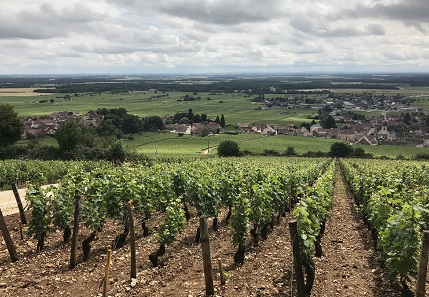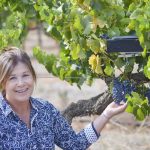Anthony Fikkers, proprietor and winemaker of small Yarra Valley wine producer Fikkers Wines, won the inaugural travel scholarship at the 2017 Victorian Wine Show which he used to investigate the use of whole bunch fermentation in Burgundy, Beaujolais and the Rhone Valley in France. The aim of the scholarship is for the recipient to gather information that could benefit the Victorian wine industry, but his observations are of interest to the broader Australian wine industry
In 2017 I won the Victorian Wine Show’s inaugural travel scholarship. I opted to use the scholarship to investigate whole bunch fermentation in red wines. In June 2018, I flew to France to explore regions that have a long history of whole bunch fermentation. I visited producers in Burgundy, Beaujolais and the Rhone Valley — regions that grow varieties that are relevant to the Victorian wine industry, like Pinot Noir, Gamay and Shiraz. I met with producers who use varying levels of whole bunch in their ferments to discuss why they do this, how they choose suitable parcels of fruit and the methods they implement to get the best results.
The producers were:
Burgundy
• Domaine Cecile Tremblay
• Domaine Chandon de Briailles
• Clos des Lambrays
• Chateau de la Tour
• Mark Haisma
• Domaine de la Cras
• Domaine de l’Arlot
Beaujolais
• Domaine Baron de l’Ecluse
• Chateau du Bluizard
• Chateau Thivin
• Domaine Thulon
• Domaine Chingard
Rhone Valley
• Domaine Graillot
• Vincent Paris
Why use whole bunch fermentation?
Many of the producers interviewed believe that using whole bunches in red ferments provides freshness and personality to their wines. Cecile Tremblay believes whole bunches tie together the fruit and tannin of her wines, giving an end result that is more complete and seamless. Maxime Graillot said the main reason he uses bunches is to create something unique — a wine that will stand out from his neighbours’ with its vibrant personality. Claude Geoffrey, from Chateau Thivin, also noted added freshness as the reason he uses whole bunch, particularly in warmer seasons.
Other producers gave very pragmatic reasons for their use of whole bunches. Geraldine Godot, from Domaine de l’Arlot, used a lot more whole bunches in 2016 because it was a low crop and she wanted to fill the fermenters; stalks helped fill the space. David Ratignier, at Domaine du Bluizard, will use 100% whole bunch in his new second winery because he will not have a destemmer there.
None of the producers aim for stalky characters in their wine. Overall, they want to achieve freshness and personality or are motivated to use whole bunches due to practical considerations.
Choosing parcels of fruit for whole bunch fermentation
Most of the producers visited use the oldest vine parcels for whole bunch fermentation. These are usually their best parcels of fruit. There seemed to be a consensus that old vines produce the smallest bunches and berries, which are desirable for whole bunch fermentation. Christian Knott, from Chandon de Brialles, named the middle of the hill as the best place to find fruit for whole bunch fermentation, because the hydric tension (soil water concentration) is ideal to ripen bunches.
Many producers said that not all vineyards produce fruit suitable for whole bunch fermentation due to naturally high tannins that can make the wines hard if whole bunches are used. Cecile Tremblay does not use any whole bunch in her wines from NuitsSaint-George because she believes the vineyards are already very tannic, but in Chambolle Musigny she uses 100% whole bunch because the approach suits the terroir. Respecting the terroir was a common refrain from the producers I visited. Mark Haisma, an Australian who makes wine in Burgundy and Rhone, summed up the shared sentiment neatly, saying, “Whole bunch needs to add, not detract, from the intrinsic character of the terroir.”
Whole bunch fermentation techniques
None of the producers I interviewed use long macerations. They all press their wines within a month (the majority within two weeks). Most of the producers who use less than 100% whole bunch mix whole bunches and destemmed fruit through the fermenter. They allow premium fruit to pass the sorting table as whole bunches and destem the inferior fruit. A small number of producers said they put whole bunches on the bottom of the fermenter, but no one said they put them on the top of ferments. Maxime Graillot uses 50% whole bunches in the bottom of the fermenter in his Beaujolais ferments because he only wants a 10-day ferment, and needs juice to get it started quickly. There was little consensus about cap management. Some producers give the top a light foot stomp once fermentation has started (e.g., Marc Soyard, Domaine de la Cras) while others plunge and/or pump over (e.g., Chandon de Briailles). At Chandon de Briailles they destem mid ferment if it looks like the stems are contributing too much tannin. The destemmed (fermenting) fruit will then be returned to the fermenter.
Several producers reported that they avoid adding sulfur dioxide to fruit, particularly before fermentation. Christian Knott, from Chandon de Briailles, suggested this was one of the more important factors in making good whole bunch wine. His theory is that sulfur hardens tannins, particularly stalk tannins, which results in a hard, unbalanced wine. He uses no sulfur dioxide prior to fermentation and believes that not adding it after the ferment increases the silkiness of the wine. He bottles five barrels of unsulfured 100% whole bunch wine each year and says that he loves to watch the ‘wild ride’ the wine takes. Oxygen was also cited as a cause of green, stemmy, whole bunch wines. Marc Soyard, at Domaine de la Cras, does not aerate his ferments in an attempt to avoid ‘greeness’.
Cecile Tremblay uses an altered whole bunch technique that she calls the ‘titi method’. Because she wants the carbonic character associated with whole bunch fermentation and avoid stemminess, she cuts out the rachis of each grape bunch but leaves the berries attached to their pedicles and peduncles — which are then tipped directly into the fermenters. This is a very labour intensive technique, but it may well play a significant part in producing the Domain Cecile Tremblay wines that are elegant and fruit driven, but structured and fine at the same time.
Another modified whole bunch technique is used extensively in the Northern Rhone. Bunches are fermented with their stems, but are first crushed by a must pump. Producers use this technique to add stalk tannin, and to control the fermentation dynamics (the stalks aerate and cool the ferment). Vincent Paris uses this ‘crushed bunch’ fermentation because he dislikes carbonic fermentation characters, and has found that whole bunch ferments usually press out with residual sugar which he wants to avoid. Maxime Graillot said he uses the crushed bunch technique to help control fermentation temperatures.
A Rhone producer I spoke to by phone immediately before I left France, Stephane Ogier, mentioned that he has had better results when using 228L barriques to age destemmed Syrah, whereas 600L demi-muids are more appropriate for whole bunch Syrah. This was an interesting insight, but unfortunately came too late in the trip to investigate further.
Additional insights
Developing new techniques in response to climate change It seems both Old and New World producers are encountering new challenges in the face of warmer vintages and ongoing climate change, and we could learn a lot from each other. Claude Geoffrey’s family have owned Chateau Thivin since 1877, but this young vigneron is keen to adapt his techniques in response to climate change. He currently uses 60% whole bunch on average, but was very clear in his intent to use more if vintages continue to get warmer. Whilst he wants to maintain the estate’s distinctive traditional Beaujolais wine style, he was eager for new information about canopy management techniques used in Australia to avoid sunburn.
Sweet tannins
One of the most enlightening visits was to a Burgundian domaine with a long history of 100% whole bunch fermentation It is participating in a trial with a major university in France, comparing the tannin profiles of 100% whole bunch wines with wines from completely destemmed fruit. Both the 100% whole bunch and completely destemmed barrel samples I tasted supported the theory that whole bunch fermentation can be used to achieve freshness and vibrancy. The whole bunch barrel had more energy and purity, with tannin supporting the fruit, while the destemmed wine was much more tannic and the fruit masked by reductive characters. The winemaker shared with me that initial findings from the university indicate a significantly higher concentration of certain tannins in the whole bunch wines and that these tannins have been found to taste sweet — but I was asked not to share any further details because the results have not been finalised or published.
It appears that stalk tannin is a key factor in achieving the freshness that’s desired by whole bunch wine producers. It will be interesting to see the results of the French tannin profile study, because the existence of sweet tannins, if proven, could potentially challenge the orthodoxy of whole-bunch haters who claim the technique will only ever result in harsh, green wines.
Discussion
In Australia, many producers are wary of using whole bunch in their red ferments due to the harsh green tannins and overtly stalky flavours that are often attributed to this technique. However, in my travels I didn’t come across any wines that possessed these characters. The Old World producers I visited and tasted with seemed to have the recipe right. Their approach was simple — choose their best old vine parcels of fruit and use whole bunches to add interest and freshness without overwhelming the wines with stalks.
Freshness was the recurring theme among producers using whole bunch fermentation. The freshness that whole bunch adds could assist Victorian and indeed Australian winemakers produce balanced wines in warmer vintages. The higher alcohols and lower natural acid levels that are a result of warmer vintages can make a wine look tired beyond its years. These wines often need correcting with both acid and water to make a balanced end product, but I believe that whole bunch freshness can complement these winemaking corrections. Despite the predominance of long-ranging traditions in France, several of the producers I spoke to were keen to hear from me how we are approaching winemaking in a warming climate. If they are willing to challenge old approaches surely we, as a younger industry, should do the same.
According to the French producers I visited, old vines are the best source of fruit for whole bunch fermentation. In Australia, the Yalumba (and Barossa) Old Vine Charter defines old vines as between 35 and 70 years old. Many Victorian regions, such as the Yarra Valley, Geelong, Beechworth and Heathcote, are approaching or are of that age, and have many vineyards that are classified as old. If the French are correct, then these regions are becoming more suitable for producing good whole bunch wines. Our old vines may provide us with a fresh approach.
This article was originally published in the 2018 December issue of the Australian & New Zealand Grapegrower & Winemaker magazine.
Photo: The view from above the town of Morey-Saint Denis, Burgundy, France





















